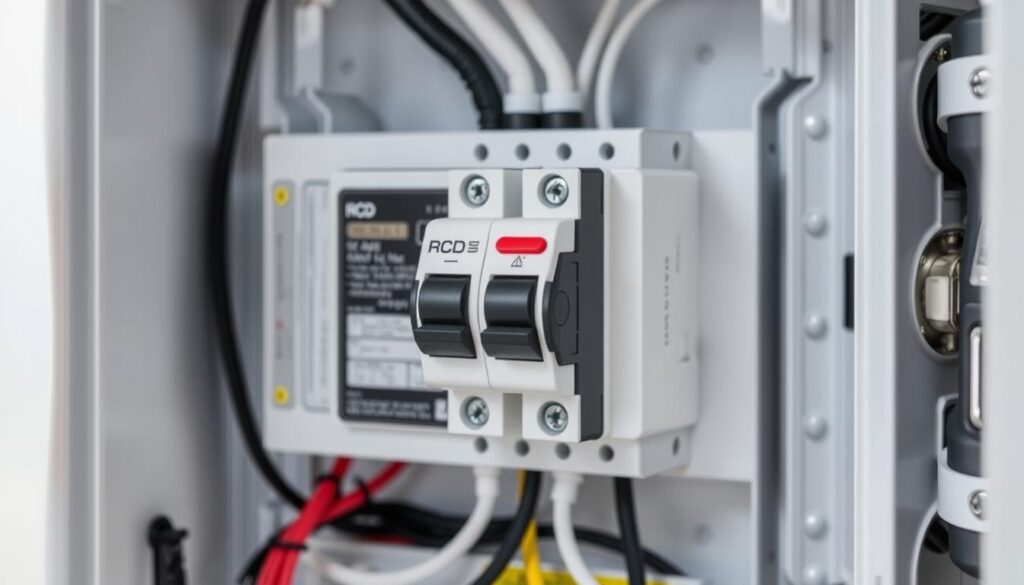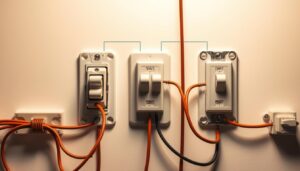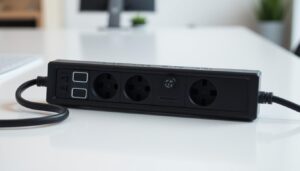Are you aware of the potential electrical shock hazards lurking within your home’s electrical system?
Installing an RCD breaker in your consumer unit is a crucial safety upgrade that can protect against such risks. According to the IET wiring regulations (BS7671:2008 +A1:2011), RCD protection is mandatory in the consumer unit for all circuits except for certain systems like smoke and burglar alarms.
This comprehensive guide will walk you through the process of installing an RCD breaker, from understanding the components to testing the completed installation. While homeowners with electrical knowledge may undertake this project, it’s essential to acknowledge the significant safety risks and legal considerations involved.
Key Takeaways
- Understand the importance of RCD protection in your home’s electrical system.
- Learn about the different types of RCD protection available for UK homes.
- Discover how to select the right components for your specific consumer unit.
- Determine whether to attempt the installation yourself or hire a qualified electrician.
- Understand the safety risks and legal considerations involved in working with your main consumer unit.
Understanding Consumer Units and RCD Breakers
Understanding the role of consumer units and RCD breakers is essential for maintaining electrical safety in UK homes. Your home’s electrical system relies on these components to protect against electrical shocks and ensure safe operation.
What is a Consumer Unit?
A consumer unit is the heart of your home’s electrical system, housing various circuit breakers that control the distribution of electrical power throughout your home. It acts as a central hub, managing and protecting your electrical circuits.
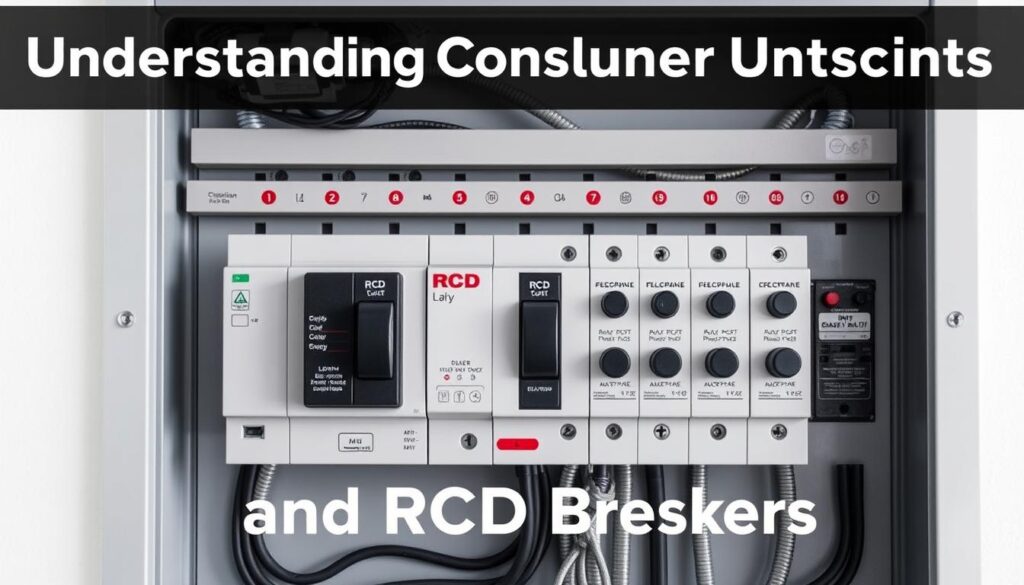
The Importance of RCD Protection
RCD (Residual Current Device) protection is vital in preventing electrical shocks. RCDs continuously monitor the electrical current flowing through your circuits, quickly disconnecting the power supply if they detect an imbalance, thus protecting you from potential electrical hazards.
“RCDs are designed to provide a high level of protection against electrical shock, making them an indispensable component of modern electrical installations.”
Types of RCD Breakers for UK Homes
UK homes typically employ several types of RCD breakers, each designed for specific applications within your single phase supply system. These include:
- Standard RCDs, protecting multiple circuits simultaneously, typically rated at 30mA sensitivity.
- RCBOs (Residual Current Breaker with Overcurrent protection), combining MCB and RCD functions for individual circuit protection.
- Time-delayed RCDs, used in circuits with brief current fluctuations, such as those powering refrigerators.
| Type of RCD | Application | Sensitivity |
|---|---|---|
| Standard RCD | Multiple circuits | 30mA |
| RCBO | Individual circuit | 30mA |
| Time-delayed RCD | Circuits with fluctuations | 30mA |
By understanding the different types of RCD breakers and their applications, you can ensure your home’s electrical system is both safe and compliant with UK regulations.
Safety Precautions Before Installation
Before installing an RCD breaker in your consumer unit, it’s crucial to take necessary safety precautions to avoid electrical shock or other hazards. Ensuring your safety is paramount, and this involves several key steps.
Turning Off the Power Supply
The first and most critical step is to switch off the main power supply to your consumer unit. Verify that the power is off using a voltage tester to ensure your safety while working on the electrical system.
Essential Safety Equipment
Wearing appropriate safety equipment is vital when working with electrical systems. This includes insulated gloves, safety glasses, and a non-conductive mat to stand on. Such equipment protects you from potential electrical shocks.
Legal Considerations for UK Homeowners
UK homeowners must comply with specific regulations when undertaking electrical work. Installing an RCD breaker is considered notifiable work under Part P of the Building Regulations in many cases. It’s advisable to contact a licensed electrician or your local building control department to ensure compliance.
- In the UK, certain electrical work must comply with Part P of the Building Regulations.
- Installing an RCD in your consumer unit may require certification by a qualified electrician.
- Homeowners can face penalties for non-compliant electrical installations.
- Consider using a registered electrician who can self-certify their work.
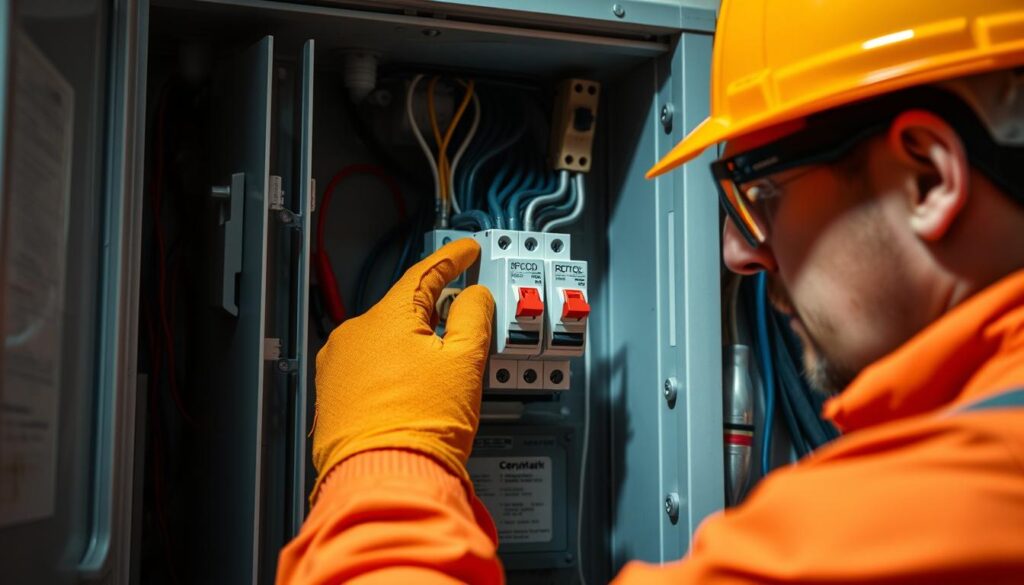
By following these safety precautions and legal guidelines, you can ensure a safe and compliant RCD breaker installation in your unit.
Tools and Components Required to Install RCD Breaker in Consumer Unit
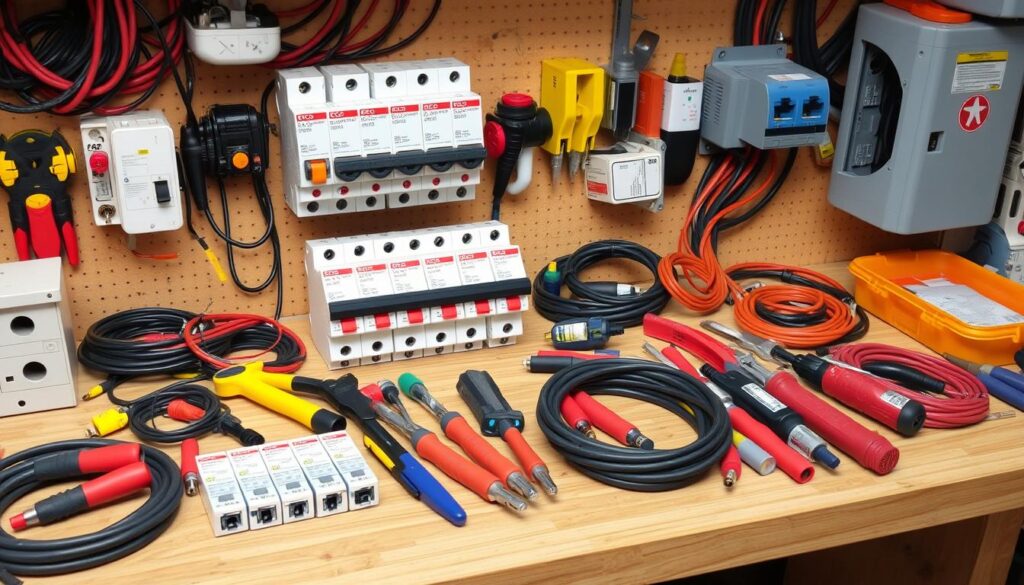
To successfully install an RCD breaker, you’ll need the right equipment and materials. The process begins with understanding the essential tools and components required for the job.
Essential Tools for the Job
Having the correct tools is crucial for the safe and efficient installation of an RCD breaker in your consumer unit. You’ll need a set of screwdrivers, wire strippers, and a cable cutter to prepare and connect the wiring correctly. Additionally, a voltage tester is essential for ensuring the power is off before you start work.
RCD Breaker Selection Guide
Choosing the the right RCD breaker involves considering the specific requirements of your electrical system, including the type of circuit protection needed and the compatibility with your existing consumer unit distribution board. Ensure the RCD breaker is rated for your system’s voltage and current.
Additional Materials Needed
Besides the RCD breaker, you’ll need cable and wiring that match your installation’s requirements—typically 10mm² or 16mm² cables. Don’t forget cable lugs or ferrules for secure connections, and consider upgrading earth and neutral bars if your unit distribution board is older. Use heat-shrink tubing in the correct colours (brown for live, blue for neutral, and green with a yellow stripe for earth) for proper wiring identification.
Step-by-Step RCD Breaker Installation Process
To install an RCD breaker, you need to understand the process thoroughly, from preparing your consumer unit to connecting the necessary wires. This step-by-step guide will walk you through the installation process, ensuring that you achieve a safe and compliant electrical system.
Preparing Your Consumer Unit
Before you start the installation, ensure your consumer unit is ready for the RCD breaker. This involves checking that the unit is compatible with RCD breakers and that you have the necessary space for the new device. It’s also crucial to identify the correct terminals for the RCD connections.
Mounting the RCD Breaker
Mount the the RCD breaker in the designated slot within your consumer unit. Ensure it clicks securely into place. The RCD breaker should be firmly fixed to prevent any accidental displacement during operation.
Connecting the Live Wire
Connect the live wire from your main consumer unit to the RCD breaker’s input terminal. Ensure the wire is securely fastened to prevent any loose connections that could lead to electrical faults.
Connecting the Neutral Wire
Similarly, connect the neutral wire to the RCD breaker’s neutral terminal. It’s essential to maintain the correct wiring color coding, typically blue for neutral, to avoid confusion and ensure safety.
Connecting the Earth Wire
Finally, connect the incoming earth/ground wire in Green with Yellow Stripe color (from the main earthing system) to the earth busbar terminal in the garage consumer unit. When working with multiple circuits, ensure that all earth wires are properly connected to the earth bar according to IEC wiring color standards.
- Identify the green/yellow earth wire from your main consumer unit’s earthing system.
- Connect this earth wire to the earth bar within your load consumer unit, ensuring a solid connection.
- The earth connection is critical for safety and must be properly secured to provide fault protection.
- In a 230V single phase supply system, proper earthing ensures that any fault current has a safe path to ground.
| Wiring Color | Function |
|---|---|
| Green/Yellow | Earth |
| Blue | Neutral |
| Brown | Live |
By following these steps and ensuring that all connections are secure and correctly wired, you can successfully install an RCD breaker in your consumer unit, enhancing the safety of your electrical system.
Testing Your RCD Installation
Testing your RCD installation is a vital step to verify that it’s working as intended and providing the necessary protection for your electrical circuits. After completing the installation, you must ensure that the RCD is functioning correctly and that all protected circuits are operating safely.
Initial Power-Up Procedure
Before testing the RCD, make sure to follow the proper initial power-up procedure. Switch on the main supply and check that the RCD does not trip immediately. If it does, identify and rectify any faults before proceeding.
Using the Test Button
Use the test button on the RCD to simulate a fault. The RCD should trip when the button is pressed. If it doesn’t, there may be an issue with the RCD or its wiring, and you should investigate further. Regular testing using the test button is essential to ensure the RCD remains functional.
Verifying Circuit Protection
After resetting the RCD, verify that each protected circuit is functioning correctly by testing lights and socket outlets. For split load consumer units, confirm that circuits are protected by the correct RCD according to your wiring circuit diagram. Use a plug-in RCD tester on socket outlets to verify the correct operation of the 230v single phase electrical wiring system.
Document your testing results as part of your main service panel records, noting the the date of installation and test results for future reference. This ensures that your RCD installation continues to provide reliable protection for your electrical circuits.
Conclusion
Completing the installation of an RCD breaker in your consumer unit marks a significant improvement in your home’s electrical safety standards. This upgrade provides essential protection against electrical shocks and fires, enhancing the overall safety of your home.
While this guide has provided detailed instructions, it’s crucial to remember that electrical work involving your consumer unit is ideally performed by a qualified electrician. Regular testing of your RCD is vital to ensure continued protection; mark your calendar for monthly test button checks.
If you’ve completed this installation yourself, consider having your work inspected by a professional electrician to ensure compliance with current regulations. The peace of mind that comes from knowing your home has proper RCD protection is invaluable, potentially saving lives and property from electrical accidents.
For more complex installations or consumer unit upgrades, always consult wiring installation tutorials or professional guidance to ensure safety and compliance. Staying informed about the latest requirements for consumer unit RCD protection is an ongoing responsibility for homeowners.
